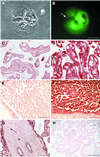Rhesus monkey placental transgene expression after lentiviral gene transfer into preimplantation embryos
- PMID: 11553810
- PMCID: PMC58541
- DOI: 10.1073/pnas.181336098
Rhesus monkey placental transgene expression after lentiviral gene transfer into preimplantation embryos
Abstract
Transgenic mice have provided invaluable information about gene function and regulation. However, because of marked differences between rodents and primates, some areas of human biology such as early embryonic development, aging, and maternal-fetal interactions would be best studied in a nonhuman primate model. Here, we report that gene transfer into rhesus monkey (Macaca mulatta) preimplantation embryos gives rise to transgenic placentas that express a reporter transgene (eGFP). Blastocysts resulting from culture of in vitro fertilized ova were transduced with a self-inactivating lentiviral vector and transferred into recipient females. One twin and one singleton pregnancy were produced from a single stimulation cycle, and one live rhesus monkey was born from each pregnancy. Placentas from all conceptuses showed expression of the transgene as detected by reverse transcription-PCR, ribonuclease protection assay, direct epifluorescence, immunohistochemistry, and Western blot analysis. Integration in somatic tissues of the offspring was not detected. A maternal immune response to the xenogeneic placental antigen was shown by the presence of anti-GFP antibodies in peripheral blood of the recipient females by day 99 of gestation (term = 165 days). These results demonstrate that transgene expression during gestation is compatible with successful pregnancy in nonhuman primates and provides an approach that could be broadly applicable to the development of novel models for primate biomedical research.
Figures



References
Publication types
MeSH terms
Substances
Grants and funding
LinkOut - more resources
Full Text Sources
Other Literature Sources

